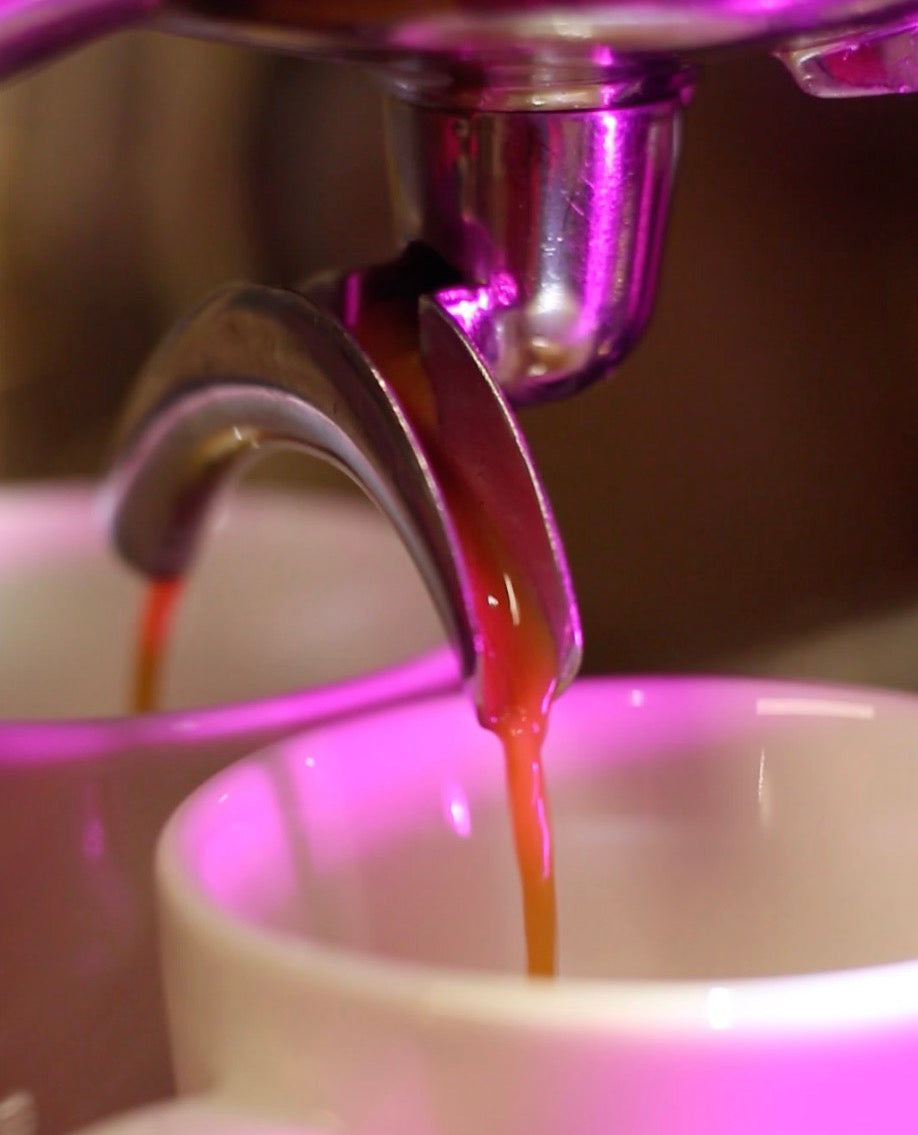Coffee Information
When I first tried this coffee—roasted by Coffee Beans—one thing that really caught my attention was the high sweetness I perceived in every sip. It was fruity and floral. It was very complex, but had a lot of clarity at the same time. It was exotic, but at the same time, very balanced. It seemed to be a coffee that delivered on all the attributes.
This coffee, produced by Jhoan Vergara at Finca Las Flores, is an example to follow for specialty coffee in Colombia. Its origin, however, has a little more context. Alfredo Vargas, co-founder of Coffee Beans, explained to me a little about the close relationship between Finca Las Flores and Finca El Diviso.
For those unfamiliar, Néstor Lasso ’s Finca El Diviso was not only the source of the coffee Carlos Medina used to win the 2022 Chilean National Filtered Coffee Championship, but also the source of the coffee Anthony Douglas used to win the 2022 World Barista Championship. Finca Las Flores, in turn, is part of a group of coffee-producing lands—of which El Diviso is also a part—and this batch of Bourbon Sidra is the closest approximation to Lasso’s methodology at El Diviso.
Las Flores began as a small farm of 2 hectares, when Edilberto Vergara and Nubia Ayure bought it in 1990. With the help and dedication of their three children—Carlos, Johan and Diego—they expanded to the current 14 hectares, with more than 90 thousand plants.
While Carlos and Diego chose to contribute from the farm's operations, Jhoan contributes from the experience he has gained by collaborating with producers from the aforementioned group, some with more experience in experimental processes —like Néstor—. As Alfredo explains to me, much of the work of these producers has been collaborative from the beginning, so it could easily be said that Las Flores and El Diviso are mere geographical distinctions.
So much so, that it is common to find coffees attributed to Néstor, but from Finca Las Flores; and coffees attributed to Jhoan, from El Diviso.
This particular batch, of the Bourbon Sidra variety, was harvested from a density reading (26% Brix). It was then kept in oxidation for 48 hours in sealed containers and exposed to a thermal shock at 50 °C. After this step, it was inoculated with Saccharomyces Cerevisiae for an 80-hour fermentation, with constant monitoring. Finally, the coffee underwent a 15-day cherry drying process, in several stages.
Producer: Las Flores Estate , Jhoan Vergara.
Country: Colombia.
Region: Pitalito, Huila.
Altitude: 1780 mts.
Variety: Bourbon Cider.
Post-harvest process: Oxidation for 48 hours, thermal shock at 50°C, fermentation inoculated with Saccharomyces Cerevisiae in an anaerobic environment for 80 hours; cherry drying for 15 days.
Harvest: January 2023.


(Photographs obtained from Finca Las Flores )
Sensory Description
Ripe strawberry, pineapple-flavored juice powder, raspberry hard candy, fresh-squeezed cranberry juice, hibiscus infusion and passion fruit flower ( passiflora edulis ).
High bright acidity, high round sweetness and low aromatic bitterness.
Medium-light body, velvety texture and perfumed finish.
Import
This coffee was purchased directly from Coffee Beans Chile , who imported it to Chile. The cost per kilo was CLP $30,345. This does not include operating costs, design or packaging —developed in conjunction with Sangre Artificial— .
Roasting
The main challenge in roasting this coffee was to achieve a profile that was light enough to maintain all the clarity of the flavors, without incorporating vegetal or herbal notes. At the same time, in slightly darker roasts, it is very easy to achieve very intense fermented flavors.
I aimed for a faster roast than usual, and at a slightly higher temperature than I would have done with similarly processed coffees. In any case, I recommend letting this coffee rest for at least 10 days to get the most out of it.
Toaster: Kaffelogic Nano 7
Load: 90 grams
Initial humidity: 12%, rehydrated to 16%
Total Time: 5 minutes, 40 seconds.
DTR: 18.5%
Final Temperature: 217 ºC
Accumulated Temperature*: 7.2
Mass loss: 15.7%

*We calculate this value by dividing the area under the roasting curve by the load, ([ºC x min] / grams). We consider this value, in our roaster, to be a reasonable approximation of the development of the coffee, in a broad sense.
Water
All King Solomon coffees are cupped with water that follows the recipe below, which we recommend for the best possible results. If you prefer a simpler option, we recommend using Nomadic Waters , since that is the water we commonly use.
To get to the recipe below you need to first make a couple of mineral concentrates. We used the recipes from Barista Hustle . Our water recipe aims for the highest extraction possible, and a balance between acidity, sweetness and bitterness.
Recipe:
— 185 ppm** of Magnesium Sulfate ( MgSO₄ ); that is, 185 grams of the Hardness concentrate.
— 38 ppm** of Sodium Bicarbonate ( NaHCO₃ ), that is, 38 grams of Buffer concentrate.
— 777 grams of deionized, demineralized or distilled water.
**As an equivalent in CaCO3.
To make things simpler, we will soon be launching our own bottled water, ready to use. Stay tuned!
Preparation
In general, our coffees are designed for high extractions. We recommend fine grinds, higher temperatures, and longer ratios—for filtered, between 1:20 and 1:23; for espresso, between 1:3 and 1:5. In addition, we tend to prefer relatively low concentrations, where we find the greatest clarity in descriptors.
The idea of including recommended recipes is not to prevent you from experimenting with coffee, but to share the recipes with which we have had good results.
Manual percolation coffee makers ( conical or flat bottom, such as V60, Origami, Kalita Wave, Kono, etc.)
Dose: 10 grams.
Water: 180 grams.
Drink: 160-170 grams.
Time : 3 - 4 minutes.
Temperature: Boiling; 97ºC in Santiago.
TDS: 1.2 - 1.3%.
First discharge — saturation or bloom — 45 grams, swirl the coffee maker for 5 seconds making sure all the coffee is wet.
Second pour of 45 grams (90) at 30 seconds. Move the coffee maker gently in circles for 2 seconds.
Third pour of 45 grams (135) just after the water level reaches the coffee. Move the coffee maker gently in circles for 2 seconds.
Final pour of 45 grams (180) just after the water level reaches the coffee. Move the coffee maker gently in circles for 2 seconds.
For increased complexity, conical makers are recommended, while for balance and clarity, flat-bottomed makers are preferable.
It is recommended to reach something close to these parameters with another coffee first. Try to make all pours from the highest possible height that does not break the flow or generate bumps on the surface of the water, in a circular motion over the coffee and maintaining a controlled flow. In addition, it is recommended to keep the water boiling between pours.
Immersion coffee makers (such as AeroPress, French Press, Hario Switch, Clever, etc.)
Dose: 10 grams.
Water: 170 grams.
Drink: 150-160 grams.
Time: 8 - 9 minutes.
Temperature: Boiling; 97ºC in Santiago
TDS: 1.3 - 1.4%
[AeroPress, standard method]
Pour the 170 grams of water over the coffee, trying to pour as quickly and from as high as possible so as not to create any bumps on the surface of the water. Stir carefully, making sure to wet all the coffee evenly.
Insert the plunger without applying pressure to create a vacuum.
At 7 1/2 minutes, with the plunger still inserted, gently move the pot in a circular motion for 5 seconds.
At 8 minutes, begin pressing the plunger very gently for 30 to 60 seconds; press all the way down.
For other immersion coffee makers, use the same proportions and start filtering after 8 minutes. For a French press, leave the filter at the level of the drink's surface, do not press all the way to the bottom and pour gently.
It is recommended to first reach something close to these parameters with another coffee, and use the finest grind with which it is still easy to press the plunger smoothly.
Espresso
Dose: 15 grams.
Water: The water you use in your espresso machine, or the recipe indicated, if you have a machine that allows it easily.
Drink: 45-50 grams.
Time: 20-25 seconds.
Pressure from pump: 6 bar
Temperature: 93-94ºC
TDS: 7 - 8%
It is recommended to reach something close to these parameters beforehand with another coffee. Let the drink cool a little before tasting. For something like a allongé , use the same parameters, but aim for a 75-90 gram drink in about 30-40 seconds. For something like a sprover , aim for 190-200 grams in about 45-60 seconds.
Zero bypass coffee makers (Tricolate, LVL-10 and Pulsar)
Dose: 10 grams.
Water: 180 grams, recipe included.
Drink: 165 - 175 grams.
Time: 4-6 minutes.
Temperature: Boiling; 97ºC in Santiago
TDS: 1.3 - 1.5%
[Tricolate]
First pour —saturation or bloom— of 30 grams, move the coffee maker for 10 seconds ensuring that all the coffee is wet or stir carefully with WDT tool.
Pour the remaining 150 grams (180) in 5-7 pulses, trying to keep the water level between 1-1.5 centimeters above the coffee. Move the coffee maker gently in circles for 3 seconds after each pulse.
For the Next Level LVL-10, use 30 grams of coffee to 540 grams of water, with a slightly coarser grind; for the Pulsar, use between 20-25 grams of dosage and maintain the ratio.
For other zero-bypass coffee makers, keep the proportions but use the dosage recommended by the manufacturer. Try to do everything on a surface that allows you to keep the coffee maker level. It is recommended to reach something close to these parameters first with another coffee. In addition, it is recommended to keep the water boiling between pours.
Music
All of our coffees also come with a Spotify playlist, featuring songs we like to listen to while brewing and drinking. Generally, the songs we include in each playlist relate to some sensory aspect of coffee; but explaining exactly how they relate goes beyond words.
Listen to Bourbon Cider Finca Las Flores on Spotify.


